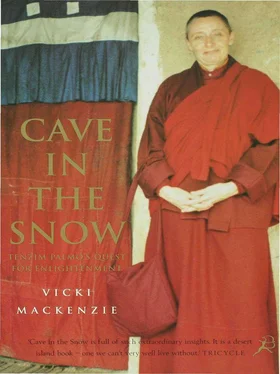’They were mostly mice and hamsters and in the autumn there were an awful lot of them. They were terribly sweet. Sometimes I used to trap them in a cage and then take them outside and let them go. It was very interesting watching them because each one you trapped had a different response,’ she said, hinting at the Buddhist belief that animals, since they possess minds, are subject to reincarnation like the rest of us. In this respect it was perfectly logical that animals could well be former or future human beings in the endless stream of becoming and unbecoming.
’Some of them were frightened and would cower in the corner of the cage. Others would be very angry and roar and try and rip the cage trying to get out. Others would put their little paws on the bars and push their noses through and look at you and allow you to pet them. They’d be so friendly. Each one had completely different reaction,’ she went on.
’Then there were the martens, which look a bit like weasels only prettier. They were grey with a white front, huge eyes and a big bushy tail. There was one that used to slide open the window get inside my store-room and head for the saucepan which had my bread inside wrapped in a cloth. This marten would take off the saucepan lid, unwrap the cloth and then eat the bread. It wasn’t like a rat, which would just gnaw through the cloth. Then it would proceed to unscrew the plastic lids of the containers holding the fat, pull off the zinc covering then eat it. It was amazing. Everything I had it would undo. I tried putting food outside for it but this would often get frozen and the marten would look so let down. I read somewhere that if you can catch one when they’re young they make excellent pets because they’re so intelligent.’
Another visitor was the little stoat which she caught sight of in her garden. It was about to run away when it obviously thought better of it and bravely decided to approach Tenzin Palmo instead.
‘It came trotting all the way up to me, stood there and looked up. It was so small and I must have been enormous to it. It just stood there looking at me. Then it suddenly became excited.
It ran back to the fence and began swinging on it, hanging upside down and looking at me all the time to see if I was still watching – like a child.’
If the animals never frightened her, there was an occasion, just one, when man did. Then it seemed that her breezy optimism that no male would bother to climb that high to harm her was sadly misplaced.
‘It was during a summer when a young boy about fifteen or sixteen years old came by with his flock of sheep. He was extremely strange. He would sit on this big boulder near the cave and look down on me. If I smiled at him he would just glare back. One morning I discovered the pole with my prayer flag on it had been thrown down. Another time the stones in my spring had been moved so the water no longer flowed. Then the window to my store-room was smashed, although nothing had been taken. I was certain it was this boy and worried because he had an infinite amount of time to sit there thinking up mischief. He could do anything he wanted! I felt very vulnerable,’ she recalled.
She was so worried, in fact, that she called on her old friends the Dakinis, praying to them in her familiar way:
‘Look here,’ she said, ‘this boy has obviously got a lot of psychological problems, so please do something to change his mind and help him,’ she prayed.
As usual the Dakinis took up Tenzin Palmo’s challenge.
‘A couple of days later I found on my gate a bunch of wild flowers. Then, when I went to my spring not only had it been repaired but it had been put back together so much nicer. After that, when I saw the boy he gave me a nice smile. He was completely transformed. Dakinis are very powerful,’ she added. And so Tenzin Palmo, the girl from Bethnal Green, learnt to live in her cave watching the seasons come and go. As the years went by life took on its own rhythms.
‘In winter, which lasted from November to May, the blizzards made it particularly difficult. There would be these great big snow drifts which I had to clear from above the cave with a shovel. That meant I had to walk through it. It was very physical work and not very good for the back. I had to throw the snow over the top of the cave. It took days sometimes. I would just finish and then it would snow again. I would do it over and over again. It had to be done for me to be able to get to my wood pile. The first snow was nice but after months and months of it I’d be saying “Oh no, not again.”
’The first signs that spring was on its way were these little rockflowers, very delicate, which would appear usually while it was still snowing. I could spend hours looking at them. Actually, spring was for me the most difficult time. The snow would thaw and come seeping through the cracks of the cave, flooding it. I could actually watch streams of water running down the walls soaking everything. I had sacks to mop it all up, which I would then have to dry and use again. I used to have to lay everything out in the sun to dry out. Even my meditation box, which was above the ground and lined with layers of cloth, would get damp. It was a real nuisance. You’d dry everything out, put it back and then it would flood again. Outside, everything got really muddy. One of the questions which Khamtrul Rinpoche had asked me when he was vetting the cave was whether it was wet. I said “no” because I honestly thought it wasn’t. If he had known how damp and musty it got he might never have agreed to let me live there,’ she conceded.
By the end of May Tenzin Palmo could begin to garden, planting her vegetables and flowers – cornflowers, marigolds, calendulas. She enjoyed gardening even though it demanded much fetching and carrying of water. For the last three years of her solitary retreat someone sent her a packet of flower seeds from England and her much to her amazement they flourished in that foreign soil, transforming her Lahouli Cave into a cottage garden.
’There were dahlias and night-scented stock. So beautiful! But I was the only one to see them,’ she said. By full summer the entire landscape had turned green – the fields, the valleys, and the willow trees planted by the Moravian missionaries to halt the erosion of the landslides. ‘Now, you could burn sitting in the sun while the part of you in the shade would still feel chilly,’ she said.
In summer the birds started coming back: the choughs, a red-legged crow, were regular visitors. She would watch them perform the beautiful aerial dances for which they are famous, and would sometimes cut pieces off a mat to provide nest furnishings for them. Once, one evening when she was coming back from a rare visit to the village, she came across an extraordinary scene.
‘As I turned a corner I saw hundreds upon hundreds of vultures sitting in circles. They were grouped on the boulders, on the ground, all around. It was as though they had come together for a meeting. I had to walk through the middle of them! There was nowhere else for me to pass. Now these birds are big, about three feet high, with hooded eyes and strong, curved beaks. I took a deep breath, started saying the “Om Mani Padme Hung” mantra and walked right through them. They didn’t even move. They just watched me out of the corner of their eyes. Later I remembered that Milarepa had had a dream in which he was a vulture and that among Tibetans these birds are regarded as extremely auspicious,’ she recalled.
With autumn the world around her was transformed into a blaze of brilliant colour. It was spectacular. ‘The mountains in front of me turned blood red crossed with lines of dazzling yellow – the willow trees whose leaves had turned. Above these were the snow mountains soaring into the bright blue sky. This was the time when the villagers would harvest their crops. I could hear them from my cave singing in the valleys below as they worked their yaks.’
Читать дальше












